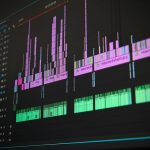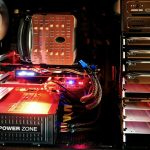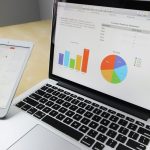When setting up your home for data analysis, it's crucial to consider your specific needs and the tasks at hand. A strong computer configuration can make a significant difference in your workflow and efficiency. From choosing the right hardware to selecting software that complements your analysis, every detail counts. But what should you prioritize to build an effective workstation? Let's explore the essential components that can elevate your data analysis capabilities.
Table of Contents
Key Takeaways
- Opt for a powerful quad-core CPU and at least 16GB of RAM for efficient data processing and analysis tasks.
- Choose an SSD for faster data access, complemented by larger HDD storage for archiving purposes.
- Utilize software like R or Python for advanced data analysis, and Tableau or Power BI for effective data visualization.
- Ensure a high-speed wired Ethernet connection for stable internet access and consider backup options for reliability.
- Create an ergonomic workspace with dual monitors and proper lighting to enhance productivity during long analysis sessions.
Understanding Your Data Analysis Needs
How do you determine what your data analysis needs really are? Start by assessing the type of data you'll be working with. Are you analyzing small datasets or handling big data? This decision impacts your requirements significantly.
Next, consider the complexity of the analyses you plan to perform. Will you run basic statistical operations, or do you need advanced machine learning algorithms? Understanding your workflow is crucial; identify whether you'll be collaborating with others and if real-time processing is necessary.
Lastly, think about your budget. It's essential to balance performance with cost to ensure you get the most efficient setup without overspending. By clarifying these points, you'll be better equipped to choose the right tools and configurations for your data analysis tasks.
Essential Hardware Components
When setting up a computer for data analysis, choosing the right hardware components is crucial to ensure optimal performance.
Start with a powerful CPU, as it processes your data quickly. Look for at least a quad-core processor.
Next, prioritize RAM; 16GB is a good baseline, but 32GB can handle larger datasets more efficiently.
Don't forget about storage—opt for an SSD for faster data access and a larger HDD for archiving.
A dedicated graphics card can be beneficial for visualization tasks.
Lastly, invest in a reliable power supply and good cooling solutions to maintain system stability.
Recommended Software for Data Analysis
When it comes to data analysis, choosing the right software is crucial for your success.
You'll find a variety of essential tools available, ranging from powerful paid options to flexible open-source solutions.
Understanding the strengths and weaknesses of each can help you make the best choice for your projects.
Essential Data Analysis Tools
As you dive into data analysis, choosing the right software tools can significantly enhance your efficiency and insights.
Start with Excel for basic data manipulation and visualization; its familiarity makes it a go-to for many. If you're ready for something more powerful, consider using Python or R. These programming languages offer extensive libraries tailored for data analysis, giving you flexibility and advanced capabilities.
For statistical analysis, tools like SPSS or SAS are also excellent choices.
Don't forget about data visualization software like Tableau or Power BI, which can help you present your findings effectively.
Lastly, cloud-based platforms like Google Sheets allow for seamless collaboration.
Choose the tools that best fit your needs, and you'll be well on your way to impactful data analysis.
Open Source vs. Paid
Choosing between open source and paid software for data analysis can significantly impact your workflow and results.
Open source tools like R and Python offer flexibility, community support, and a plethora of libraries without any cost. They're ideal if you're looking to customize your analysis or dive into coding. However, they may require more time to learn and troubleshoot.
On the other hand, paid software like Tableau or SPSS provides user-friendly interfaces and robust customer support, making them suitable if you prefer a straightforward experience. They often come with advanced features that can save you time.
Ultimately, your choice should align with your budget, expertise, and specific analytical needs to ensure you get the most out of your data analysis efforts.
Budget-Friendly Configurations
While you might think that powerful data analysis requires a hefty budget, there are plenty of budget-friendly configurations that can meet your needs without breaking the bank. You can achieve effective data analysis with a combination of a decent CPU, enough RAM, and storage options that fit your workflow. Here's a quick overview of some configurations to consider:
| Component | Budget Option |
|---|---|
| CPU | AMD Ryzen 5 3600 |
| RAM | 16GB DDR4 |
| Storage | 512GB SSD |
| GPU | Integrated Graphics |
With these components, you'll have a solid setup to tackle data analysis projects without overspending. Remember, it's all about balancing performance and cost!
High-Performance Setups
When you're aiming for high-performance setups in data analysis, picking the right hardware and software is crucial.
You'll want to focus on essential components that can handle large datasets efficiently while also considering cost-effective options.
Let's explore how to strike the perfect balance for your needs.
Essential Hardware Components
To effectively tackle data analysis, you need a powerful hardware setup that can handle large datasets and complex computations.
Start with a multi-core processor, like an Intel i7 or AMD Ryzen 7, which accelerates processing speed significantly. Pair it with at least 16GB of RAM for smooth multitasking; 32GB is even better for heavier workloads.
A solid-state drive (SSD) is essential for fast data access and loading times, so consider getting one with 1TB capacity or more.
Don't forget a dedicated graphics card if you're working with data visualization or machine learning tasks.
Lastly, invest in a reliable cooling system to maintain optimal performance during intensive sessions.
With these components, you'll be well-equipped for any data analysis challenge.
Optimal Software Choices
Having the right hardware is just the beginning; optimal software choices can elevate your data analysis capabilities even further.
Start with a powerful data analysis tool like R or Python, which offer extensive libraries for statistical analysis and data visualization. Consider adding SQL for managing and querying databases efficiently.
For advanced analytics, explore software like Tableau or Power BI to create compelling visualizations and dashboards. Don't forget about version control systems, like Git, to manage your code effectively.
Additionally, using cloud platforms, such as AWS or Google Cloud, can enhance your computational power and storage options.
Budget-Friendly Options
While you might think high-performance setups require a hefty budget, there are plenty of budget-friendly options that can still meet your data analysis needs.
Start by considering a refurbished laptop or desktop from reputable brands. These machines often come with powerful processors and enough RAM for most data tasks at a fraction of the cost.
Additionally, look for systems with SSDs for faster data access and processing. You can also build your own desktop; customizing components allows you to prioritize performance without overspending.
Finally, don't overlook open-source software; it can save you money while providing robust tools for data analysis.
With the right choices, you can achieve high performance without breaking the bank.
Future-Proofing Your Workstation
As technology evolves at a rapid pace, ensuring your workstation remains relevant becomes essential for efficient data analysis. To future-proof your setup, invest in high-quality components that can adapt to changing demands.
Start with a powerful CPU and GPU, as they significantly impact data processing and visualization. Opt for ample RAM—16GB is a minimum, but 32GB or more is ideal for heavy multitasking.
Consider storage solutions like SSDs for faster data access and backup options in the cloud for added security. Make sure your motherboard supports future upgrades, such as additional RAM slots or newer connections.
Lastly, don't overlook peripherals—ergonomic keyboards and monitors can enhance your comfort and productivity. With these choices, you'll stay ahead in the data analysis game.
Frequently Asked Questions
How Do I Choose the Right Monitor Size for Data Analysis?
When choosing the right monitor size for data analysis, consider your workspace and viewing distance. A larger screen enhances visibility, while dual monitors can improve productivity by allowing you to view multiple datasets simultaneously.
Can I Use a Laptop Instead of a Desktop for Data Analysis?
Yes, you can use a laptop for data analysis. Just ensure it has sufficient processing power, RAM, and storage. A good display and comfortable keyboard will also enhance your overall experience while working.
What Peripherals Are Essential for Data Analysis Work?
For effective data analysis, you'll need a reliable monitor for clear visuals, a comfortable keyboard for typing, and a mouse for precision. Consider noise-canceling headphones to maintain focus and a good chair for long hours.
How Often Should I Upgrade My Computer for Data Analysis?
You should upgrade your computer every three to five years, depending on your workload and software requirements. Keeping your hardware up-to-date ensures optimal performance and helps you efficiently handle increasingly complex data analysis tasks.
Are There Specific Brands Known for Reliability in Data Analysis Hardware?
When choosing reliable hardware for data analysis, consider brands like Dell, HP, and Lenovo. They're known for durability and strong performance. You'll find their models often recommended by professionals in the data analysis field.




